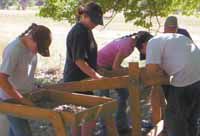| Campers learn what to watch for as they sift through the soil. |
During the waning days of June six Emery High School students; Keera Allred, Tamra Luke, Kassie Allred, Kennedy Kemple, Joel Jensen and Brady Jensen and two chaperons; myself and my son-in-law, Steve Weber, were given the unique opportunity to fully participate for four days in the University of Utah’s eight week Archaeology Field School at the Wilcox Ranch in Range Creek Canyon. This opportunity was part of a pilot program sponsored jointly by the Emery County Economic Development Council, Emery County, and the Emery County School District designed to expose the young people of Emery County to a broad spectrum of vocational opportunities through a series of summer camps. Aside from the archaeology camp this year’s program gave additional students the opportunity to participate in four other camps exposing them to such diverse subjects as theatre, paleontology, criminal investigation, and entrepreneurship as well as a special dino-day camp for younger students.
The university’s archeology field school is an intensive eight-week field course designed to teach basic archaeological field methods to undergraduate college students from all over the country who are pursuing professional careers in archaeology. Under the direction of Dr. Duncan Metcalfe (Associate Professor of Anthropology and Curator of Archaeology, Utah Museum of Natural History), our students were given the opportunity to fully participate with 12 college students in receiving training in a variety of archaeological field techniques including survey, mapping, soil identification, aspects of paleo-ecological research, as well as modern archaeological field and lab techniques in an ongoing field research program.
Our adventure began at 8:30 in the morning on June 20 when we loaded our gear into three waiting vehicles parked in the Huntington Stake Center parking lot and began the three hour drive to Range Creek. The drivers, Sheriff Lamar Guymon, Ray Petersen, and Steve Weber made the trip pass quickly by keeping the conversation going and in about an hour and a half we found ourselves at the abandoned Wild Horse Canyon mine facility. Here we took time to stretch our legs and were given an interesting and informative 20 minute presentation by Petersen, Administrator of Emery County Public Lands Department, on the geology and the recent history of the area afterwhich we loaded back into our transportation and continued our journey through Wild Horse Canyon and up the narrow, steeply inclined road which crosses the pass at the 8,700 foot level and descends again to the main gate of Range Creek where we were met by a pair of park rangers who unlocked the gate and escorted us to the ranch. Yes, the entry gates are locked at all times and if you enter via motorized vehicle you must be escorted at all timesand obtain a permit. Numerous prehistory sites containing Indian writings, granaries, and pit houses dot the road between the front gate and the ranch complex property and can be seen from the road by the observant hiker.
We arrived at the Wilcox ranch complex at lunch time and were greeted by Dr. Metcalfe (who prefers to be addressed as Duncan rather than Dr. Metcalfe) and his staff who made us feel at home and invited us to join them for lunch. After lunch, we unloaded and staged our gear in the camping area (Duncan, his staff, and the college students are housed in tents in a beautiful, park like setting adjacent to the main ranch buildings) and joined them at the main building for what would be the pattern of our daily activity for the remainder of our stay; a short lecture on some aspect of archaeology, a description of the day’s activities, and the division into groups after which we picked up our water and field gear and headed out into the “field” to complete the day’s assignments. Once in the field we were treated by the instructors just like one of the undergraduates fully participating in using the equipment, making measurements, surveying sites, and recording the results.
| Brady Jensen notes the coordinates of a point in Range Creek. |
The teaching syllabus for the week we were there mainly involved historic archaeology (archaeology of the site since contact by Europeans). This involved using GPS equipment and technology to map the ranch complex, collecting and documenting historic artifacts, and using the “total station” device (a device similar to a GPS device but which is capable of recording locations in three dimensions and is mainly used to produce a topographic map of a site) to document the features of “historic” Range Creek in preparation for preservation of the complex. Realizing this wasn’t the Indiana Jones type daring-do archaeology that we were anticipating Duncan, his staff and the undergrads extended themselves to insure we had the opportunity to experience “pre-historic” archaeology “up close and personal”. Each evening, after supper and clean-up, members of the U’s team arranged for Emery students to hike into or, in some cases, up to pre-historic sites around the area where we were allowed unprecedented access, at times coming within feet if not inches, of Indian writings, granaries and artifacts.
Waldo Wilcox, whose family owned the ranch for decades, and recently sold it to the Division of Wildlife Resources, came back to the ranch to meet the campers and teach them the history of the ranch.
After four days immersed in archaeology and field work we struck camp, bid tearful goodbyes to our new colleagues, loaded up our gear and returned to civilization with its comfortable beds, showers, and air conditioning, an adventure behind us that we will all remember the rest of our lives. All of us who participated in this project deeply appreciate the hospitality of the University, the students, and Dr. Metcalfe and his staff in allowing the students of Emery this unprecedented access to their world.

